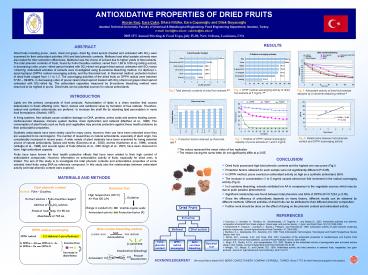ABSTRACT PowerPoint PPT Presentation
1 / 1
Title: ABSTRACT
1
ANTIOXIDATIVE PROPERTIES OF DRIED FRUITS Hicran
Koç, Esra Çakir, Dilara Nilüfer, Esra Çapanoglu
and Dilek Boyacioglu Istanbul Technical
University, Faculty of Chemical Metallurgical
Engineering, Food Engineering Department,
Istanbul, Turkey. e-mail koch_at_itu.edu.tr
cakires_at_itu.edu.tr 2005 IFT Annual Meeting Food
Expo, July 15-20, New Orleans, Louisiana, USA
ABSTRACT Dried fruits including prune, raisin,
dried red grape, dried fig, dried apricot
(treated and untreated with SO2) were examined
for their antioxidant activities (AA) and total
phenolic contents. Methanol and ethyl acetate
solvents were also tested for their extraction
efficiencies. Methanol was the choice of solvent
due to higher yields of total extracts. The total
phenolic contents of fruits, found by
Folin-Ciocalteu method, varied from 1.63 to 5.08
mg GAE/g extract, in decreasing order, prune
gtdried apricot treated with SO2gtdried red
grapegtdried apricot untreated with SO2gtraisin
gtdried fig. Antioxidant activities of extracts
were investigated using ßcarotene bleaching
method, 2,2 diphenyl-1-picryl-hydrazyl (DPPH)
radical scavenging activity, and the Rancimat
test. In Rancimat method, protection factors of
dried fruits ranged from 1.1 to 1.2. The
scavenging activities of the dried fruits on DPPH
radical were between 37.82 89.90, in
decreasing order of prunegtraisingtdried apricot
treated with SO2gtdried red grapegtdried apricot
untreated with SO2gtdried fig. The antioxidant
capacities measured by ßcarotene bleaching
method were observed to be highest in prune.
Dried fruits can be potential sources for natural
antioxidants.
INTRODUCTION Lipids are the primary compounds of
food products. Autooxidation of lipids is a chain
reaction that causes deterioration in foods
affecting color, flavor, texture and nutritional
value by formation of free radicals. Therefore,
natural and synthetic antioxidants are prefered
to increase the shelf life by retarding lipid
peroxidation in many food formulations (Shahidi,
1997). In living systems, free radicals cause
oxidative damage on DNA, proteins, amino acids
and amines leading cancer, cardiovascular
diseases, immune system decline, brain
dysfunction and cataract (Madhavi et al., 1996).
The consumption of plant foods such as fruits and
vegetables may provide protection against these
health problems by their antioxidative
properties. Synthetic antioxidants have been
widely used for many years, however, their use
have been restricted since they are suspected to
be carcinogenic. The number of researches on
natural antioxidants, especially of plant origin,
has considerably increased in recent years. A
wide variety of plant materials have been
examined for being potential source of natural
antioxidants. Spices and herbs (Exarchou et al.,
2002), berries (Kahkönen et al., 1999), cereals
(Velioglu et al., 1998) and several types of
fruits (Murcia et al., 2001Singh et al., 2001)
have been observed to have high antioxidant
capacity. Fruits have been known for their
health protective effects that have been related
to their high content of antioxidative compounds.
However, information on antioxidative activity of
fruits, especially for dried ones, is limited.
The aim of this study is to investigate the total
phenolic contents and antioxidative properties of
some selected dried fruits using BHA as reference
compound. In this study also the relationships
between antioxidant activity and total phenolic
content were explored.
a The values represent the mean value of two
replicates b The means having the same letter do
not significantly differ at p?0.05
- CONCLUSION
- Dried fruits possessed high total phenolic
contents and the highest one was prune (Fig1) - Protection factors obtained for each sample were
not significantly different (Pgt0.05). - In DPPH method, prune exerted an antioxidant
activity as high as a synthetic antioxidant, BHA.
- The increase in concentration (1 to 5 mg/ml)
caused almost two fold increment in the radical
scavenging activity (Fig 4). - In ?-carotene bleaching, extracts exhibited low
AA in comparison to the vegetable sources which
may be due to polar paradox phenomenon. - Significant relationship was found between total
phenolics and SA of DPPH (R20.7224, p?0.05). - Since the efficiency of antioxidants depends on
many factors, different results can be obtained
by different methods. Different activities of
dried fruits can be attributed to their different
phenolic composition. - Further work should be done on the effect of
drying on the phenolic content and antioxidant
activity.
MATERIALS AND METHODS
Total phenolic content
Rancimat Test
Method Folin Ciocalteu Extract solution
Folin-Ciocalteu reagent Addition of Na2CO3
solution Stand at room temp. for 90
min Absorbance at 765 nm
High temperature (110 oC) Air flow (20 L/h)
Oxidation
Change in conductivity
Volatile organic acids
Antioxidant activity Protection factor (F)
- REFERENCES
- Exarchou, V., Nenadis, N., Tsimidou, M.,
Gerothanassis, I.P, Troganis, A., and Boskou,D,.
2002. Antioxidant activities and phenolic
composition of extracts from Greek oregano, Greek
sage, and summer savory. J. Agric. and Food Chem.
50 (19) 5294-5299. - Kahkönen,M.P., Hopia,A.I., Vuorela,H.J.,
Rauha,J. Pihlaja,K. and Heinonen,M. 1999.
Antioxidant acitivity of plant extracts
containing phenolic compounds. Journal
Agricultural and Food Chemistry 47 3954-3962 - Madhavi, D.L., Deshpande, S.S., Salunkhe, D.K.
1996. Food Antioxidants Technological,
Toxicological and Health Perspectives. Markel
Dekker, New York - Murcia, M.A., Jimenez, A.M., and Tome, M.M.
2001. Evaluation of the antioxidant properties of
mediterranean and tropical fruits compared with
common food additives. Journal of Food Protection
64(12) 2037-2046 - Singh, R.P., Murthy, K.C.N., and Jayaprakasha,
G.K. 2002. Studies on the antioxidant activity of
pomegranate peel and seed extracs using in vitro
models. Journal of Agricultural and Food
Chemistry 50 81-86 - Velioglu, Y.S., Mazza, G., and Oomah, B.D. 1998.
Antioxidant activity and total phenolics in
selected fruits, vegetables, and grain products.
Journal of Agricultural and Food Chemistry
464113-4117
Beta caroten bleaching method
DPPH radical scavenging
heat
Linoleic acid free
radicals
- DPPH radical
- DPPH? AH DPPHH A?
- DPPH? R? DPPHR
2,2-diphenyl-1-picrylhydrazyl
Autooxidation
Discoloration
?-carotene
Discoloration (bleaching)
Decrease in absorbance
Prevent discoloration
Free radicals
Antioxidant
ACKNOWLEDGEMENT We would like to thank HACI
BEKIR CONFECTIONERY COMPANY (ISTANBUL, TURKEY,
Since 1777) for their financial support to the
project.

